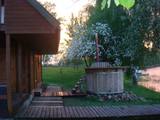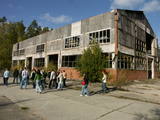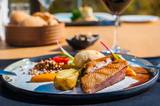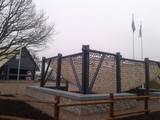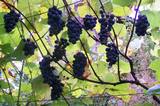| Nr | Nosaukums | Apraksts |
|---|---|---|
|
Lauku māja pie Sartų ezera netālu no Sartų zirgu audzētavas, Dusetų hipodroma, kur katru gadu pirmajā februāra sestdienā notiek pie zirgu skriešanās sacīkstes. Trīs sešvietīgi namiņi ar terasi, tualeti, dušu un virtuvīti. Lielākai ģimenei vai draugu kompānijai moderna, bet autentiska Vecā māja ar 5 numuriem aprīkotiem ar dušu un tualeti, virtuvi. Basketbola, volejbola un bērnu rotaļu laukumi. Tradicionālā dūmu pirts, kubls. Atpūtnieki var izmantot laivas un ūdens velosipēdus, kajakus un velosipēdus. Maršruti pa Sartų ezeru, Šventosios un Kriaunos upēm. Izjādes, riteņbraukšana pa Sartai Reģionālo parku. Makšķerēšana. Viesu nama saimnieki siltajā laikā aicina viesus nogaršot āra virtuvē gatavotos ēdienus (plovu, omleti, pīrāgus). Ēdienu gatavošanai tiek izmantoti pašu dārzā izaudzētie dārzeņi. |
||
|
Dievnams celts laikā no 1937. – 1940. gadam, un par tā prototipu kalpojusi Kauņas Augšāmcelšanās baznīca Lietuvā. Ēka ir vienjoma celtne, kas veidota funkcionālisma arhitektūrai raksturīgās ģeometriskās taisnstūra formās. Tās iekšpusē ir liels koka altāris, kancele un abi sānu altāri (darināti 19. gs. sākumā), kas savulaik greznojuši Rokišķu baznīcu. No Rokišķu baznīcas tos pārveda tādēļ, ka pēdējā tika izveidots jauns interjers. 1997. g. baznīcai piešķirts Eiropas kultūras mantojuma Zilais karogs. Blakus dievnamam atrodas 19. gs. otrajā pusē no sarkanajiem ķieģeļiem celtie vecās katoļu baznīcas vārti un Sēļu parks. |
||
|
Saulkrastos netālu no Baltās Kāpas un Saulrieta takas posmā no Bērzu ielas līdz Selgas ielai gar jūru izbūvēts jauns pastaigu takas posms un izveidots vides objekts “Saulrieta vērotājs”. Tas ir foto objekts, kur jaunlaulātie un ikviens Saulkrastu iedzīvotājs, viesis var iemūžināt atmiņas Saulkrastiem tik raksturīgajā saules simbolā. |
||
|
Viens no iespaidīgākajiem bijušās PSRS armijas objektiem Ziemeļvidzemē ar pamestām ēkām, pazemes bunkuriem, raķešu noliktavām, to palaišanas laukumiem u.c. elementiem. Viena no dažām vietām Latvijā, kur redzams Ļeņina piemineklis. Akmenī kaltais Ļeņina galvas atveids padomju gados bija novietots Alūksnes centrālajā laukumā. Atmodas laikā to demontēja un pārveda uz kodolraķešu bāzi. Īpaši slepens militārs objekts, kas ir spilgta Aukstā kara liecība. Bāzē aizvien labi saglabājušies dažādi angāri, raķešu palaišanas laukumi un bumbu patvertnes. Objektu var atklāt individuāli, kopā ar vietējo gidu vai izmantojot audio gida sniegtās iespējas. Iesakām ceļojumu laikā sākt Zeltiņu vēstures krātuvē, kur dota iespēja ieskatīties padomju laika sadzīvē un uzzināt par darbību padomju armijas raķešu bāzē! |
||
|
This tour will give you an impression of the eastern part of Latvia, which is less populated and also less popular among tourists. You will first arrive in Aluksne and explore the town, which is located at Alūksne highland, on the shore of Lake Alūksne. It is worth visiting Temple Hill – an old Latgalian castle mound and the place of the old town, Sun bridge, and the Castle manor park, Alūksne Lutheran Church and the Bible Museum. After staying there overnight you will go by bus to the start point of the hike in Ape. This Forest Trail section winds through a hilly farmland landscape, then enters a large dark forest, occasionally interrupted by the blue surfaces of lakes. After Peļļi, it crosses the Latvian/Estonian border and winds along the shores of the lakes Smilšājs, Sūneklis and Ilgājs for 2 km on the Estonian side, known as Paganamaa (translation: Devil's Land). There it descends and enters the Korneti-Peļļi subglacial depression, one of the most impressive ravines in Latvia. The Forest Trail returns to Latvia at Lake Ilgājs and, after a steep climb, takes you through a hilly area to the Drusku castle mound. Here you can enjoy a beautiful view. At the end of this tour, you will reach Korneti. The section is located in the protected landscape area “Veclaicene”. |
||
|
Meklējama uz dienvidiem no Ludzas pilskalna, vietā, kur paveras skaists skats un Lielo Ludzas ezeru. Pirmā katoļu baznīca Ludzas Baznīckalnā bija celta 1687. g., taču tā nodega ugunsgrēkā. 1738. g. uzcēla jaunu koka baznīcu baroka stilā, ko krāšņā interjera dēļ dēvēja par Latvijas skaistāko koka dievnamu. Tā nodega 1938. g. lielajā pilsētas ugunsgrēkā. Tagad redzamās celtniecību uzsāka 1939. g., bet pilnībā pabeidza un atjaunoja tikai deviņdesmito gadu sākumā. |
||
|
Saimniecībā, kas atrodas Raunas upes krastā, audzē dažādas zivju sugas. Ziemas piedāvājumā ir dažādu lašveidīgo zivju makšķerēšana, bet vasarā var makšķerēt stores, sīgas, tilapijas un foreles. Sillakās var arī iegādāties zivis, bet apmeklētāju grupām sagatavo zivju degustāciju. Sillakas atrodas ~ 3 km no Liepasmuižas. |
||
|
No Neļķu klintīm, kas atrodas Skaņākalna parkā, paveras skaistākais Salacas ielejas skats uz smilšakmens klinšu ieloku un upes mierīgo tecējumu. Labi skati no Velna kanceles. Vērts aiziet līdz Skaņamkalnam un pabaudīt slavenās atbalss klints skatus. Atrodas ZBR.
|
||
|
The restaurant is located in the first five-star hotel located outside the cities in Latvia, in a beautiful place with a story and a future - in Amatciems. Chefs use local, natural products to prepare meals and serve them with a contemporary interpretation and an emphasis on taste and quality. |
||
|
The museum is in the Lielvārde Park. It is in the granary of the Lielvārde Estate that was built in the early 19th century. It was later used as a residential building. A veranda was added to it in 1922. The museum has been there since 1970, and it features exhibits about the Latvian national epos “Lāčplēsis” and its author, Andrejs Pumpurs (1841-1902). The museum also features information about the history and ethnography of the Lielvārde Administrative District. Alongside it is a large rock that weighs around 80 tonnes and is known as Lāčplēsis’ Bed. A broken part of the rock is known as the Lāčplēsis blanket. Both rocks were once on the banks of the Daugava River next to the Lielvārde island. Waters from the Ķegums hydroelectric power plant now make waves in that area. Nearby is the so-called Spīdala log that was brought from Aizkraukle.
|
||
|
Das einzige Museum solches Maßstabs unter freiem Himmel im Baltikum. Gegründet in 1999. Die Ausstellungsobjekte einbezogen die monumentalen Denkmäler spiegeln die sowjetische Ideologie wieder. Ein Minizoo. |
||
|
This park was set up to protect the landscape and cultural environment of the Haanja highland. At the central part of the park are the two highest hills in the Baltic States – Suur Munamägi, which stands 318 m above sea level, and Vällamägi, which is 304 m above sea level. The ancient Rõuge River valley (Rõuge ürgorg) is found in the western part of the park. It is 7.5 km long and up to 60 m deep. The valley dates back to the Ice Age, and it has seven lakes, including the deepest one (38 m) in Estonia – Lake Rõuge Suurjärv.
|
||
|
The saloon is in the centre of Vecumnieki and features antique household objects as part of its interior design. Breakfast, lunch and dinner are all prepared on an open fire, making use of an ancient spirit and the cookbooks of grannies. Desserts, too, are all made from natural ingredients. Latvian cuisine: Pork with sauerkraut. Special foods: Handmade pierogi with home-cured meat. |
||
|
Baltijā lielākā keramikas fabrika. Tūristu grupām piedāvā ekskursiju pa ražotni. Blakus atrodas veikals, kurā var iegādāties keramikas izstrādājumus – gan praktiskas lietas, gan interjera priekšmetus un suvenīrus. |
||
|
Meklējama Tārgales ciema centrā. 2018. g. nogalē atklāta Lībiešu zvejnieku sēta ar dzīvojamo māju, kurā ir saimes galds un soli, kūti, tīklu žāvētavu un mākslīgi radīts kāpas fragments. Sēta veidota kā atklāta tipa objekts un to var apmeklēt jebkurā laikā. Apkaimē saglabātas vietējās koku sugas. |
||
|
The café is located 200 m south of the Stāmeriena Castle in Vecstāmeriena. It is in one of the historical buildings of the local baronial estate and has an antique interior. It is possible to try out dishes typical for Gulbene district. |
||
|
„Zaļmuiža” (Green Manor) is notable because of its legendary past. The protector of peasants and poet Peter
Miglinīks (1850 – 1883) worked there as a clerk in the beginning of the 19th century. In 1784, the building belonged
to Frederick von Korf. The manor was bought by officer of Russian army Nikolaj Paulin von Rosenschild. Once
the manor had a large farm (800 ha): several cattle-sheds, fruit and wine cellars, alcohol brewery. Now there in
only a manor house and a barn. Till 1960s, the manor house was the centre of kolkhoz „Liesma”, later the club.
Now there is a smithy of a craftsman Jānis Ļubka. Guests are welcome to watch and try the metal processing.
|
||
|
Atrodas Raiņa ielā 18. Baznīca celta 1911. - 1912. g. pēc Stukmaņu muižas nomnieka barona R. Noldes iniciatīvas. 1. pasaules karā cietušo baznīcu atjaunoja un no jauna iesvētīja 1921. g. Baznīcā apskatāma altārglezna “Kristus augšāmcelšanās”. Dievnams tāpat kā daudzas citas pilsētas ēkas ir būvētas no apkaimē sastopamā izejmateriāla – dolomīta. Interesanti, ka tornis būvēts ēkas vienā malā – asimetriski. |
||
|
The distinguished Latvian author an painter Jānis Jaunsudrabiņš (1877-1962) spent six years of his childhood at Riekstiņi in Nereta. He was born into a servant family and moved to Riekstiņi together with his mother after his father passed away. The household inspired him for his "White Book." In honour of Jaunsudrabiņš, a museum was opened at Riekstiņi in 1967, and it is in an authentic Selonian farm with its spirit and aromas. You can tour the residential building and the homestead's granary and wheelhouse, also houshold building from 1820. The apple orchard has trees that are 100 years old and older. Nearby is the Ķišķi cemetery (on the side of the Vecumnieki-Ilūkste road), where members of the Jaunsudrabiņš family were interred and Jānis Jaunsudrabiņš was reburied in 1997. The Nereta Administrative District still has many single family farms and place names which Jaunsudrabiņš mentioned in his books. |
||
|
The visitors are offered the excursion around the wine garden and the story about different sorts of grapes and the secrets of wine-making. During the excursion the vistiors can learn about the traditions of growing grapes in Latvia, to see and taste the newest tendencies of grape selectioning,as well as receive advice on growing and tending grapes. It is also possible to try home-made wines and buy grapes saplings. |
||
